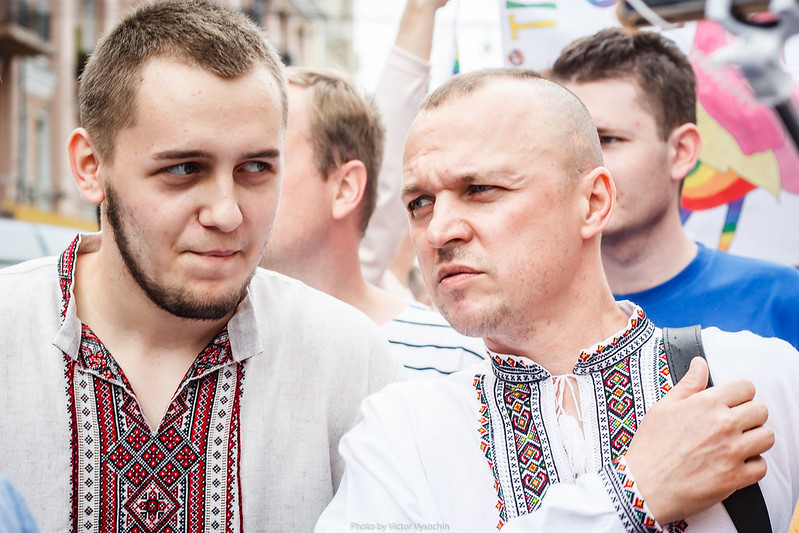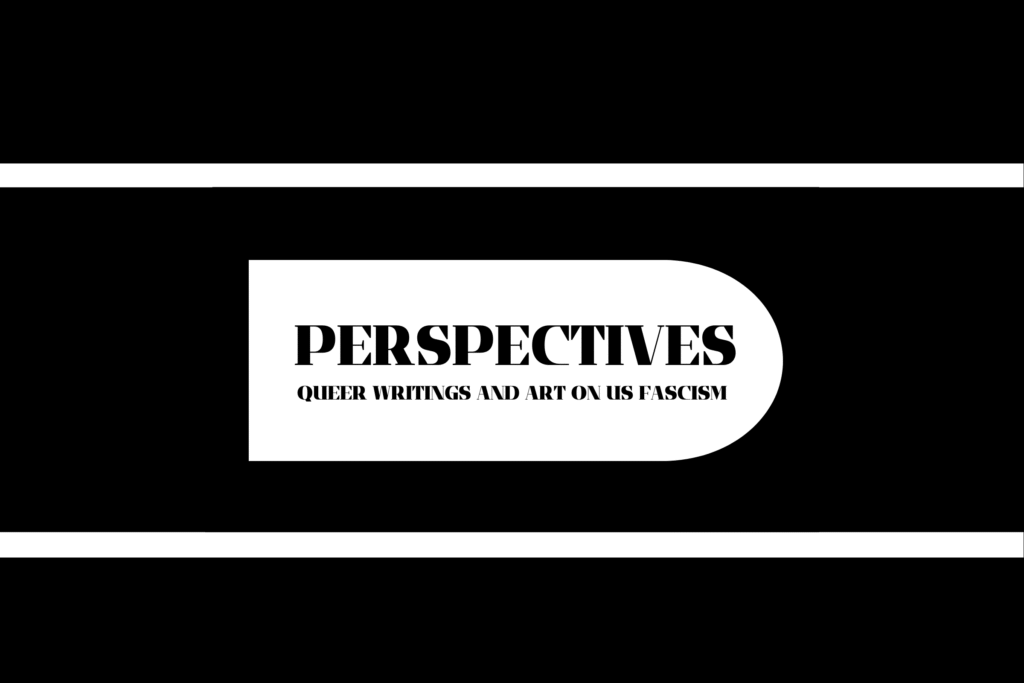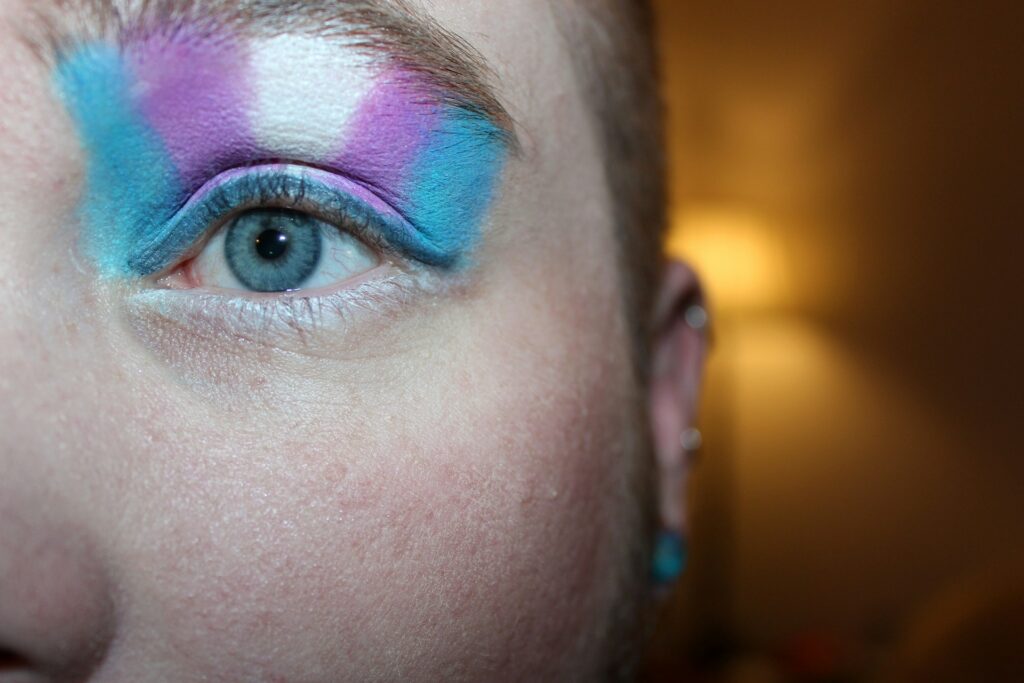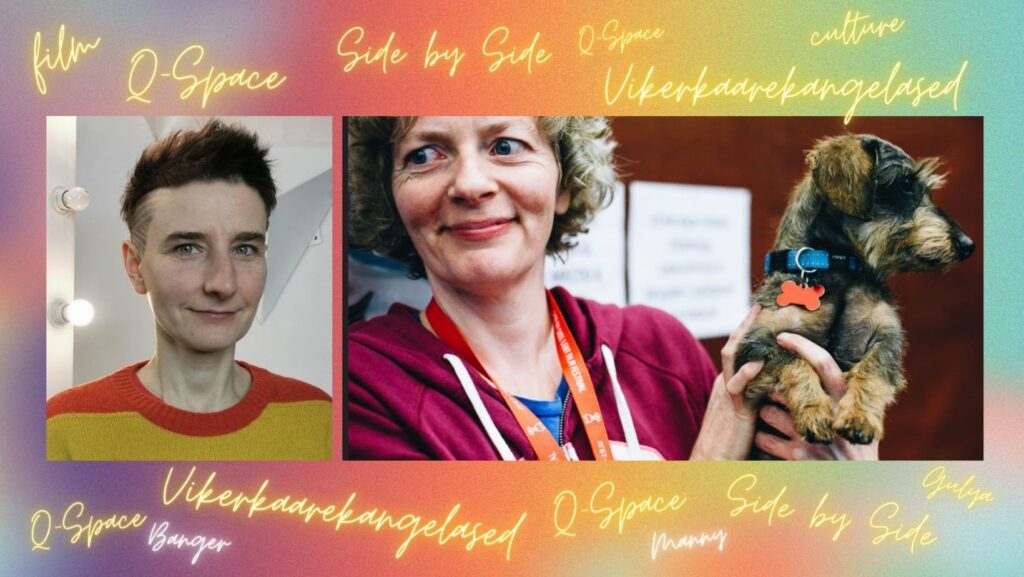Do wars have a sexual orientation? On the Russian invasion, LGBTQ rights and civil society resistance in Ukraine
Feminist scholars had a long time ago pointed out that militarization of society in the conditions of war usually “cements” traditional gender roles. Men are expected to be brave and defend their country, and women are presented as mothers and wives, victims in need of protection, the ones responsible for taking care of children and the elderly. The third month of the full-scale invasion of Ukraine by Russia shows that some gender stereotypes were challenged and disrupted, for example, by Ukrainian women soldiers making up around 15% of Ukraine’s army facing Russia on the battlefield. Still, this war, like many others, is deeply gendered; as women are encouraged to protect themselves and their children and leave their cities, all men between 18- and 60-year-old are forced to stay in the country in case they need to be mobilised.
Nevertheless, what is the situation for those who do not fit in heteronormative gender binaries and whose sexuality and gender identity are not seen as “normal” or “traditional” by a large part of Ukrainian society? The scholars and activists who tried to bring attention to LGBTQ people’s concerns during the war invasion were criticised for doing so as they allegedly required some ‘special’ rights for these people. However, is it so? This piece aims to prove the legitimacy of those concerns by offering a brief reflection on how this war affected the Ukrainian LGBTQ community.
LGBTQ rights in Ukraine before February 24, 2022
Ukraine has never been a paradise for LGBTQ people where they would be able to live comfortably, enjoying equal rights with their cisgender heterosexual counterparts. Ukraine decriminalized homosexuality in 1991, once it acquired its independent status, yet no substantial progress was made for almost two decades afterward. However, after the so-called Revolution of Dignity in 2013/14, when the pro-Russian government was forced by a popular protest to leave the country and was replaced by pro-European political forces, some visible positive steps towards LGBTQ equality were made.
In 2015, under the pressure of the European Union and thanks to the tremendous work of civil society activists in and beyond Ukraine, the first national document that explicitly mentioned sexual orientation and gender identity was adopted. The Labour Code of Ukraine was amended and now protects LGBTQ people from discrimination at the workplace. This remains the only document protecting LGBTQ people at the national level. Same-sex marriage is not recognized in Ukraine, and neither is a registered partnership, while conversion therapy is considered legal.
From 2015 to 2022, LGBTQ activism in Ukraine gained much visibility thanks to the activists’ advocacy efforts and international support. In 2021, equality marches for the rights of LGBTQ people took place in such major Ukrainian cities as Kyiv, Odessa, Kharkiv, and Zaporizhzhia under the protection of police and with the approval of local authorities. The same year the Ministry of Science and Education of Ukraine approved the course for teachers of Ukrainian schools to prevent bullying of LGBTQ teenagers. Much progress has been made in the sphere of healthcare regarding transgender people.
At the same time, the protection of the rights of LGBTQ people has never been a priority of any major Ukrainian political party. For most Ukrainian politicians, it has been inconceivable to express support for LGBTQ rights publicly. Orthodox Church and some conservative nationalist organizations continuously pressured the government into new measures to disrupt the work of LGBTQ and feminist organizations, and smaller radical far-right groups regularly attacked LGBTQ and women’s rights events. Not surprisingly, when the Russian invasion started in February 2022, LGBTQ organisations and activists did not count on public institutions’ sensitivity or widespread attention to their cause.

Kyiv Pride 2018. Photo: Arrideo Photography / Creative Commons
We [also] were here: LGBTQ soldiers in the Ukrainian army
Ukraine has compulsory military service, and homosexuality is not a reason for exemption from it. Many young gay men were trying to avoid going to the army or keeping their sexual orientation hidden while serving due to the fears of facing sexual violence and abuse. After the annexation of Crimea by Russia and the start of the war with Russia in Donbas, one of the most popular arguments used by the opponents of LGBTQ rights in Ukraine was that, as there was war in the country, it was not a good time for marches of equality and protection of LGBTQ rights. Moreover, as some far-right activists liked to say, “those gay men should be sent to war and not be allowed to march in the center of Kyiv demanding some special rights.”
Primarily as a response to those claims, in August 2018, a photo exhibition “We were here” was inaugurated in Kyiv, where several LGBTQ people, veterans, and soldiers, their faces covered in the photos, told their stories. Soon afterward, an initiative LGBT military was launched. After the leader and co-founder of the initiative, Viktor Pylypenko, a gay veteran of the Donbas Volunteer Battalion, had made his public coming out in media, the initiative kept growing. Since summer 2018, they have always had a separate column during the March of Equality, organised by KyivPride. The column was led by Viktor Pylypenko and openly lesbian volunteer Nastya Konfederat.
As the invasion started, most of the veterans joined active military forces or the groups of territorial defence. In their group on Facebook, they collect funds for military supplies and publish reports on their activities. At least once a week in this group, you can see posts of the soldiers coming out to the public. The core message of these posts is very similar: we [LGBTQ people] are also here, we are citizens of Ukraine, we are ready to give our lives to defend this country, we want you to see us, acknowledge our presence, and we expect that in post-war Ukraine we will have the right to be visible, to be included in the Ukrainian society and to create families with the people we love.
Persistent homophobia
Though the war in a country often makes people forget about their ideological disputes and unite against the common enemy, it would be wrong to say that Ukrainian society got rid of homo and transphobia overnight. On April 7, Olena Shevchenko, the chair of an LGBTQ rights group Insight, was attacked by an unknown man with pepper spray in L’viv, a Ukrainian city in Western Ukraine, right after she and her colleagues had loaded “humanitarian aid for women and children” onto a bus. The attacker was Ukrainian, highly likely a member of one of the far-right organizations that are notoriously famous for their violent attacks on LGBTQ and feminist events also in peaceful times.
In Kyiv, in March, the office of the oldest Ukrainian LGBTQ rights organisation Nash Mir was attacked by a group of bandits who broke the door to the office, where four activists were also living, brutally beat and robbed the people inside the flat. In this case, however, it is unclear who the attackers were. Since the assault took place as Russian troops were advancing towards Kyiv, this could be blamed on both sides. Moreover, experts working on far-right groups in Ukraine from 2014 to 2022 repeatedly pointed out that many of these groups were funded from Russia or pro-Russian forces in Ukraine, always encouraging homophobic hate crimes and societal homophobia.
While the police register such crimes, it is clear that it is not their priority as the war unfolds – it was not so even before February 24, 2022. With growing militarization and the level of violence in society, natural for the times of military conflicts, under-protected by the state groups, such as LGBTQ people, find themselves even more vulnerable.

Kyiv Pride 2018. Photo: Arrideo Photography / Creative Commons
Emergency mode: professional LGBTQ activism in the times of war
Before February 24, 2022, more than 40 officially registered LGBTQ organisations worked in Ukraine. Their activities included working with the MSM group on HIV prevention, psychological support of various groups, awareness raising, education, legal support, documenting and preventing homo and trans phobic hate crimes, and advocacy of LGBTQ rights. As the invasion started, it became clear that many of these activities could not be implemented while, at the same time, an acute need in providing humanitarian assistance, creating shelters, and helping those in need to flee emerged.
In response to this need, several shelters were created in Kyiv, Western Ukraine, and bordering Eastern European countries for LGBTQ people and their families and pets who have nowhere to live or pass the place as transit and need to stay for some nights. In addition to supplying the shelters with the basic stuff for people to stay there, LGBTQ organisations also collect and distribute food and medicines. They buy transportation tickets or pay for some bills for those LGBTQ people in need who, for various reasons, cannot leave their homes or do not have the means to survive. For the trans community, the question of regular hormone supplies is the most pressuring one. Such organisations as Cohort or Insight, with the help of foreign partners, work hard to receive hormones in Ukraine in a centralised manner and then send them to various cities to provide people with at least one-month supply.
It is important to point out that while, for LGBTQ organisations, it is a priority to protect and assist LGBTQ people, most of them put much effort into collecting funds and providing humanitarian aid to the general population. They also collect medical supplies for the soldiers in Ukrainian hospitals and military ammunition for the people on the front line.
Most donors agreed to re-channel at least a part of the funding to humanitarian needs. Some of the donors active in Ukraine launched new initiatives for emergency action. Nevertheless, it is still not enough to cover all the basic needs of displaced LGBTQ people, so all the organisations are trying to crowdfund as much as possible.
The right for safety: who is allowed to flee the country?
As I mentioned above, all men between 18- and 60-year-old were forced to stay in Ukraine by the government’s decree. A group that faced unexpected consequences of this decree are Ukrainian trans women, many of whom have not started or have not completed their legal transition yet. Therefore, they still have the gender marker “M” in their documents.
During the last decade, Ukraine has made visible progress concerning the rights of the transgender population; currently, Ukraine has the most favorable conditions for trans people in the non-EU post-Soviet space regarding changing the documents and legal and medical aspects of transition overall. Since 2017, the treatments mandatory for trans people, such as sterilisation and a long stay in a psychiatric institution, have been cancelled. Still, due to the lack of information and complicated bureaucratic procedures, many trans women have never completed the document change process and, thus, could not leave Ukraine.
In theory, one can go to a doctor to obtain a necessary certificate and then apply to the military office for an exemption. However, it is not feasible for most in the conditions of bombing and martial law enforcement. Some trans people get so desperate that they try to fake the loss of the documents and cross the border without them, yet this is extremely risky and can easily result in them being captured and imprisoned.
It is necessary to say that not all trans people expressed the desire to leave Ukraine, and some are very determined to stay in their home cities and, if necessary, fight. The head of the Ukrainian NGO Cohort working particularly with trans rights, Anastasiia Yeva Domani, who currently works in Kyiv, said in her interview with UNAIDS that she stays to continue her work helping trans people all over Ukraine. Nevertheless, as she pointed out, it is not surprising that some people want to flee; for many years, trans people in Ukraine have been overlooked by the state. They were discriminated against, had no job and proper home, and nothing kept them in Ukraine.

Kyiv Pride 2018. Photo: Arrideo Photography / Creative Commons
Instead of a conclusion
Ukraine has never been a paradise for LGBTQ people. In the situation of the full-scale invasion for all vulnerable and marginalised groups, LGBTQ people being not an exception, the life conditions worsened substantially. Everyday life for many has turned into pure survival. Many LGBTQ people were forced to leave the country, fleeing war, and now they face the risk of becoming victims of racism, xenophobia, and discrimination in places where they are not welcome for who they are.
Still, there is some room for hope. While all European countries have come united in helping displaced people from Ukraine, the same happened to LGBTQ organisations worldwide. Starting from the first day of the Russian invasion, such organizations as RFSL Sweden, PFLAG USA, KPH Poland, Munich Kyiv Queer Germany, and many others have been working day and night fundraising, sending humanitarian aid, organizing relocation, providing shelter, participating in peaceful protests in their countries and advocating rights of LGBTQ Ukrainians. Similarly, in Ukraine, many LGBTQ rights NGOs and activists are working in solidarity with other organisations dealing with the rights of LGBTQ people and other groups and organisations helping civilians and the military. Through this cooperation, I believe the acceptance and tolerance toward each other are growing.
The war often cements conventional norms and stereotypes. However, eight years of war in the east of Ukraine and the first months of the full-scale war with Russia have shown that some of these norms can be challenged and successfully destroyed. Whether the same can apply to homo- and transphobia in Ukrainian society is nobody’s but our choice.











